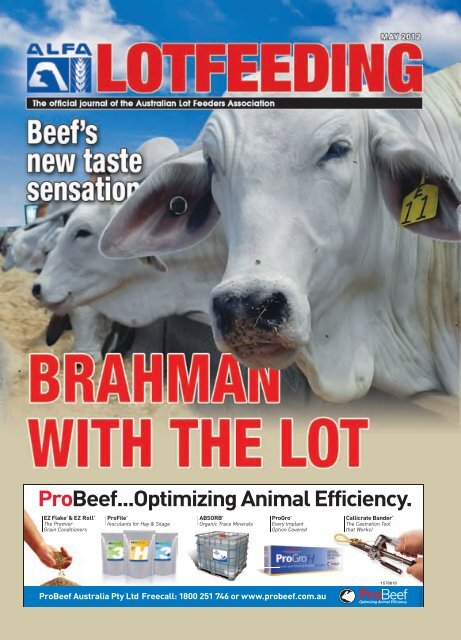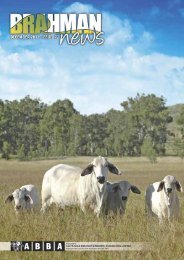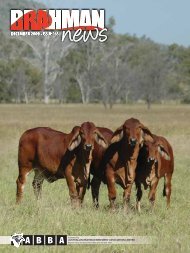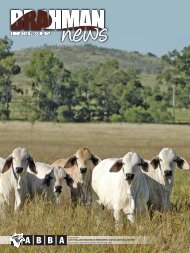Lot Feeding Journal - Australian Brahman Breeders Association
Lot Feeding Journal - Australian Brahman Breeders Association
Lot Feeding Journal - Australian Brahman Breeders Association
You also want an ePaper? Increase the reach of your titles
YUMPU automatically turns print PDFs into web optimized ePapers that Google loves.
1578818
ALFA News<br />
By IAN PATERSON<br />
<strong>Brahman</strong>s with the lot<br />
THE cornerstone of profitable beef<br />
production is cattle that produce<br />
a high-yielding, high-value and<br />
high-quality carcase at the lowest<br />
possible cost, says <strong>Australian</strong> <strong>Brahman</strong><br />
<strong>Breeders</strong> <strong>Association</strong> general manager<br />
John Croaker.<br />
The cattle need to be able to not only<br />
survive, but also thrive across a range<br />
of conditions and environments, having<br />
the adaptability to perform on grass,<br />
forage crops and in the feedlot, no<br />
matter what the season, he says.<br />
Mr Croaker (pictured)<br />
also said thatstudies<br />
by leading <strong>Australian</strong><br />
research bodies<br />
keep confirming that<br />
<strong>Brahman</strong>s are performing<br />
second-to-none in<br />
fulfilling all the key economic requirements<br />
for profitable beef production.<br />
Mr Croaker cited the example of a<br />
recent Beef CRC Genetic Technologies<br />
trial of eight breeds, which found that<br />
<strong>Brahman</strong>s were the most efficient beef<br />
producers, having the lowest net feed<br />
intake (NFI).<br />
The CRC’s net feed intake test<br />
measured the amount of feed con-<br />
● From previous page<br />
outside users. The cattle supplied to the<br />
Melbrig Feedlot are sourced through on-farm<br />
and saleyards purchases from the North<br />
Burnett and Central Queensland region. Cattle<br />
that are placed in the feedlot from co-mingled<br />
mobs of cattle are prevaccinated.<br />
The feedlot has a strong supply chain alliance<br />
with one of the major supermarkets and<br />
purchases flat-back cattle for the<br />
domestic trade with an intake live weight of<br />
BEEF AUSTRALIA 2012<br />
THE <strong>Australian</strong> <strong>Brahman</strong> will continue to be<br />
in the spotlight at the Beef Australia 2012<br />
<strong>Brahman</strong> Compound, which will display 40<br />
pens of <strong>Brahman</strong> cattle and offer a large<br />
range of promotional material about the<br />
adaptable, high-performing breed.<br />
sumed by an animal compared to what<br />
is expected for an animal of that age<br />
and weight.<br />
The trial tested 469 progeny of<br />
<strong>Brahman</strong> cows, bred to <strong>Brahman</strong>,<br />
Charolais, Limousin, Hereford, Santa<br />
Gertrudis, Belmont Red, Shorthorn<br />
and Angus bulls.<br />
These cattle were born at either<br />
Brigalow Research Station or Duckponds<br />
Research Station in Central<br />
Queensland and raised together at<br />
Duckponds before entering the Beef<br />
CRC’s Tullimba Research Feedlot, near<br />
Armidale, NSW, for an average of 59<br />
days on feed. The trial showed that the<br />
most efficient breed was the straight<br />
<strong>Brahman</strong>, with a NFI of -0.61kilograms<br />
per day, meaning that they ate<br />
0.61kilograms per day less than the<br />
amount expected for their weight and<br />
weight gain. This compared with the<br />
Melbrig’s<br />
MSA <strong>Brahman</strong><br />
between 300 and 400 kilograms. For the<br />
export market, they purchase Santa Gertrudis<br />
crossbred and <strong>Brahman</strong> crossbred cattle with<br />
an intake live weight of between 420 and 480<br />
kilograms.<br />
poorest performers, the Angus-sired<br />
cattle, which had a NFI of +0.30kilograms<br />
per day.<br />
CRC for Beef Genetic Technologies<br />
CEO Heather Burrow said the research<br />
inferred that animals with a<br />
low NFI would perform better than<br />
their higher NFI counterparts, whether<br />
in a feedlot, on pasture, in dry seasonal<br />
conditions or on abundant feed.<br />
As feed efficiency is one of the most<br />
economically important production<br />
traits, having a herd of low NFI cattle<br />
could allow higher stocking rates or<br />
longer grazing times for each paddock,<br />
a significant factor in regions with high<br />
land costs.<br />
Dr Burrow said the NFI information<br />
would be particularly useful to stud<br />
breeders and lot feeders.<br />
“<strong>Lot</strong> feeders could use the NFI<br />
results as a drafting tool and pay a<br />
premium for cattle that they knew<br />
would perform in the feedlot,” she says.<br />
While renowned for their performance<br />
on pasture across Northern Australia,<br />
purebred <strong>Brahman</strong>s are fast<br />
establishing themselves as standout<br />
performers in feedlots.<br />
Central Queensland <strong>Brahman</strong> breeders<br />
Peter and Ann Kirk and family,<br />
● To p30<br />
Apart from feeding their own cattle, the<br />
Hutchinson family are highly respected for<br />
custom-feeding cattle for outside vendors. Mr<br />
Hutchinson feels the Melbrig Feedlot has been<br />
a success story due to their openness and<br />
integrity when dealing with suppliers, buyers<br />
and vendors of custom-fed cattle. In addition<br />
to this the efficiency of the operation along<br />
with their attention to detail in feeding rations<br />
and animal health has provided a high<br />
level of customer satisfaction.<br />
14 LOTFEEDING, May 2012
ALFA News<br />
IAN PATERSON explains why Meat & Livestock<br />
Australia has employed chefs to lift awareness of<br />
cooking traits and methods:<br />
THE <strong>Australian</strong> <strong>Brahman</strong> <strong>Breeders</strong><br />
<strong>Association</strong> has joined forces with<br />
Beef Australia 2012 and the Ascot<br />
Stonegrill Restaurant to showcase<br />
the tenderness and quality of <strong>Brahman</strong><br />
beef.<br />
Eight <strong>Brahman</strong> cattle producers have<br />
custom fed 94 <strong>Brahman</strong> steers at the<br />
Melbrig Feedlot, Mundubbera, for 101<br />
days specifically for the Ascot Stonegrill<br />
Restaurant.<br />
The cattle were processed at Teys<br />
Australia meatworks in Biloela, with all<br />
of the 90 <strong>Brahman</strong> cattle grading to MSA<br />
standard to provide consumers with the<br />
finest meat quality traits.<br />
Ascot Stonegrill Restaurant has been<br />
a feature at the last two Beef Australia<br />
events and returns to the Beef Australia<br />
Exposition 2012 in partnership with<br />
ABBA, one of the country’s leading beef<br />
breed societies.<br />
ABBA general manager John Croaker<br />
says he’s thrilled about the initiative as it<br />
will demonstrate the “extraordinary<br />
quality, taste and tenderness” of properly<br />
prepared and cooked <strong>Brahman</strong> beef to<br />
customers at Beef 2012.<br />
As well as being MSA approved, the<br />
<strong>Brahman</strong> beef will be halal certified.<br />
The Ascot Stone Grill will serve fillet,<br />
striploin and rump with the cube roll for<br />
steak burgers. As well as serving more<br />
than 1000 steaks a day, oxtail stew, steak<br />
and kidney, and blade steak casserole<br />
will also feature on the mouth-watering<br />
menu.<br />
The initiative comes as the preparation<br />
and cooking of beef to best practice<br />
gains traction as being critical to<br />
customer satisfaction and the reputa-<br />
‘<br />
The final process<br />
of cooking beef to<br />
its optimal standard<br />
can be the difference<br />
’<br />
between success<br />
and failure.<br />
tion of the <strong>Australian</strong> grain and grassfed<br />
beef industry’s product.<br />
While each link of the beef supply<br />
chain strives for continual improvement<br />
and best practice, the final process of<br />
cooking beef to its optimal standard can<br />
be the difference between success and<br />
failure, sometimes undermining the<br />
hours of work and investment that<br />
precedes the meal preparation.<br />
Despite the beef industry’s pursuit of<br />
excellence, consumers still remark that<br />
they find inconsistent quality beef at retail<br />
and food service outlets in Australia.<br />
MLA has recognised the issue and<br />
has employed professional chefs like<br />
David Carew to lift awareness of cooking<br />
traits and methods to <strong>Australian</strong><br />
industry and consumers.<br />
Out of a total promotional expenditure<br />
of $196 million last financial year,<br />
at least $5 million was allocated to this<br />
important area of cooking beef to its<br />
optimal standard.<br />
David Carew says the exercise is<br />
nothing new. He wrote the ‘How to cook<br />
a perfect steak’ notebook while doing<br />
MLA to ‘get technical’ with cuts<br />
MLA’s own ‘master chef’ David Carew will<br />
attend Beef Australia 2012, to demonstrate<br />
seam cutting of beef secondary cuts.<br />
Mr Carew will discuss technical innovations that<br />
MLA has designed to assist the value proposition.<br />
Mr Carew will also showcase SmartShape<br />
ideas and introduce menu designs with MSA<br />
‘cut to cook’ principles, which aim for better<br />
utilisation of carcases.<br />
Mr Carew will demonstrate to Beef 2012 visitors<br />
three components to add value to the<br />
<strong>Brahman</strong> to g<br />
<strong>Australian</strong> beef supply chain. These are:<br />
● Plate profiling: Identify centre of plate<br />
opportunity from a secondary cut and prepare<br />
meat to deliver on plate expectation<br />
● Cut to cook: Grading individual muscle meat<br />
based on MSA grading to categorise muscle<br />
performance<br />
● Menu design: a pathway to deliver ultimate<br />
value for every part of a primal. It encourages<br />
more use of red meat, ultimately increasing<br />
menu opportunities.<br />
promotional work for MLA at Royal<br />
Easter in Sydney nearly 20 years ago.<br />
Howard Verwey, owner of Stonegrill<br />
International Pty Ltd, who introduced<br />
the stonegrill dining concept into Australia<br />
in 1985, says he can’t wait for<br />
consumers to taste the results of the<br />
<strong>Brahman</strong> beef.<br />
The stonegrill cooking method is now<br />
16 LOTFEEDING, May 2012
et a grilling<br />
The stonegrill cooking<br />
method is poised to<br />
show <strong>Brahman</strong> beef at<br />
its very best.<br />
used in more than 150 restaurants in<br />
Australia and is now marketed worldwide<br />
under the Stonegrill brand in more<br />
than 60 countries worldwide.<br />
Mr Verwey says stone grilling of meat<br />
on rocks can be traced back to the<br />
ancient Egyptians and Vikings.<br />
The volcanic rock used to make the<br />
stone grill is mined in South Australia<br />
and manufactured in Melbourne.<br />
Mr Verwey says the stone grill business<br />
just keeps growing and has captured<br />
the interest of diners and<br />
restaurateurs. It’s now used in restaurants,<br />
cafes, international hotels, clubs<br />
and resorts with outstanding success.<br />
Mr Verwey says stonegrill dining is<br />
recognised as being one of the healthiest<br />
methods of cooking red meat.<br />
Will Cordwell, owner of Ascot restaurant,<br />
says he’s been serving the best<br />
quality steak he can procure for his<br />
stone rock grill for the past 15 years and<br />
will never consider another model.<br />
He says the customer’s meal remains<br />
hot and enjoyable, as the natural<br />
volcanic stone retains a prime cooking<br />
temperature for 30 minutes.<br />
“This allows diners to eat at leisure,<br />
with every bite as hot and delicious as<br />
the first,” he said.<br />
Beef Australia 2012 chief executive<br />
officer Roger Desailly says the exposition<br />
has a focus on the sector of the beef<br />
industry that cooks and presents beef to<br />
food service and customers.<br />
He says that as well as Ascot Stonegrill<br />
Restaurant initiative, the PFD<br />
Food Services Awards of Excellence will<br />
be presented, recognising the outstanding<br />
work of local chefs and restaurants<br />
in preparing outstanding beef meals.<br />
Mr Desailly says Coles Supermarket<br />
is a new sponsor of Beef Australia 2012.<br />
“Coles Supermarkets is once again<br />
intrinsically in tune with the mood of<br />
consumers and the need to fill the<br />
ALFA News<br />
Eight <strong>Brahman</strong> cattle producers have custom fed 94 <strong>Brahman</strong> steers at the Melbrig Feedlot,<br />
Mundubbera, for 101 days specifically for the Ascot Stonegrill Restaurant.<br />
MLA master chef David Carew, pictured<br />
promoting Aussie beef in Korea, is heading to<br />
Rockhampton this month to provide tips on<br />
beef preparation and carcase utilisation.<br />
knowledge gap on cooking red meat at<br />
home in all age demographics,” Mr<br />
Desailly said.<br />
“The cooking demonstrations will<br />
have something for the home chefs, busy<br />
mums; school aged children and hungry<br />
teenagers, barbecue loving dads and all<br />
in between”.<br />
Beef 2012 will also feature past<br />
Master Chef contestants demonstrating<br />
ways to prepare beef dishes.<br />
LOTFEEDING, May 2012 17
1590684<br />
ALFA News<br />
BeefEx stars in<br />
tough times<br />
THE grain-fed beef industry’s<br />
BeefEx event<br />
returns to its stamping<br />
grounds at the<br />
Royal Pines Resort on<br />
Queensland’s Gold Coast,<br />
from October 9-11.<br />
While tough trading conditions<br />
continue to prevail,<br />
ALFA’s events committee<br />
chair Gina Lincoln, is determined<br />
to create a program<br />
that will compel strong<br />
attendance.<br />
“When times are tough at<br />
the feedlot, it’s more important<br />
than ever to get away,<br />
spend time with others in<br />
the industry and take a<br />
moment to learn, enjoy the<br />
● From p14<br />
Petann Pastoral Co, Weir<br />
Park, Gogango, Qld, lot feed<br />
2000-3000 head a year at Waterfall<br />
Feedlot near Goomeri,<br />
in Southern Queensland. Typical<br />
weight gains for the<br />
Kirks’ <strong>Brahman</strong>s are 2.5-<br />
2.7kg per day for steers and<br />
2.3kg per day for heifers,<br />
over 100 days on grain.<br />
“We feed cattle that we<br />
buy in and we breed and<br />
nothing is doing better than<br />
the <strong>Brahman</strong>s,” said the<br />
Kirk’s lot-feeding manager<br />
Kevin Geddes. “Where a<br />
Euro-cross might be gaining<br />
2.2 to 2.6kg a day, it’s eating<br />
16 kilograms, compared to<br />
the <strong>Brahman</strong> that’s eating<br />
13 kilograms. The feed conversion<br />
is great and that<br />
means more profit.<br />
“We’re averaging 335 to<br />
345kg dressed at two years<br />
of age.<br />
“Most are milk or two<br />
tooths, generally with 13 to<br />
15 mm of fat at the P8 site.<br />
From mob to mob they’re<br />
never less than five cents off<br />
networking and entertainment<br />
that BeefEx offers,”<br />
Gina said.<br />
“Our aim is to design a<br />
program that is the right<br />
combination of quality information<br />
and outstanding entertainment.<br />
“We have a track record<br />
of doing that and the bar is<br />
even higher this year.”<br />
Significant registration<br />
discounts will be available to<br />
ALFA members attending<br />
the event.<br />
● For information on registration,<br />
sponsorship, exhibition opportunities and<br />
programming, contact event managers<br />
Esther Price Promotions on<br />
esther@estherprice.com.au<br />
<strong>Brahman</strong>s with the lot<br />
the top of the grid.”<br />
Craig Forest, manager of<br />
Saxby Feedlot at Kilkivan,<br />
also in Southern Queensland,<br />
can also attest to the<br />
performance of <strong>Brahman</strong>s on<br />
grain.<br />
He said <strong>Brahman</strong>s adapted<br />
well to the feedlot, had<br />
the lowest maintenance requirements<br />
of any breed, required<br />
less medical attention,<br />
and were efficient feed<br />
converters, meaning they<br />
were cheaper to feed.<br />
Other feedlots have also<br />
reported significantly<br />
reduced sickbay costs –<br />
averaging about $20 per<br />
head less than other breeds,<br />
which is a significant factor<br />
when feedlot margins are<br />
tight.<br />
“We need to push the<br />
issue of cost of gain rather<br />
than daily weight gain. You<br />
can get great weight gain,<br />
but it’s the cost of gain that<br />
makes the profit and in turn<br />
provides sustainability<br />
for the operation,” Mr<br />
Forest said.<br />
30 LOTFEEDING, May 2012






